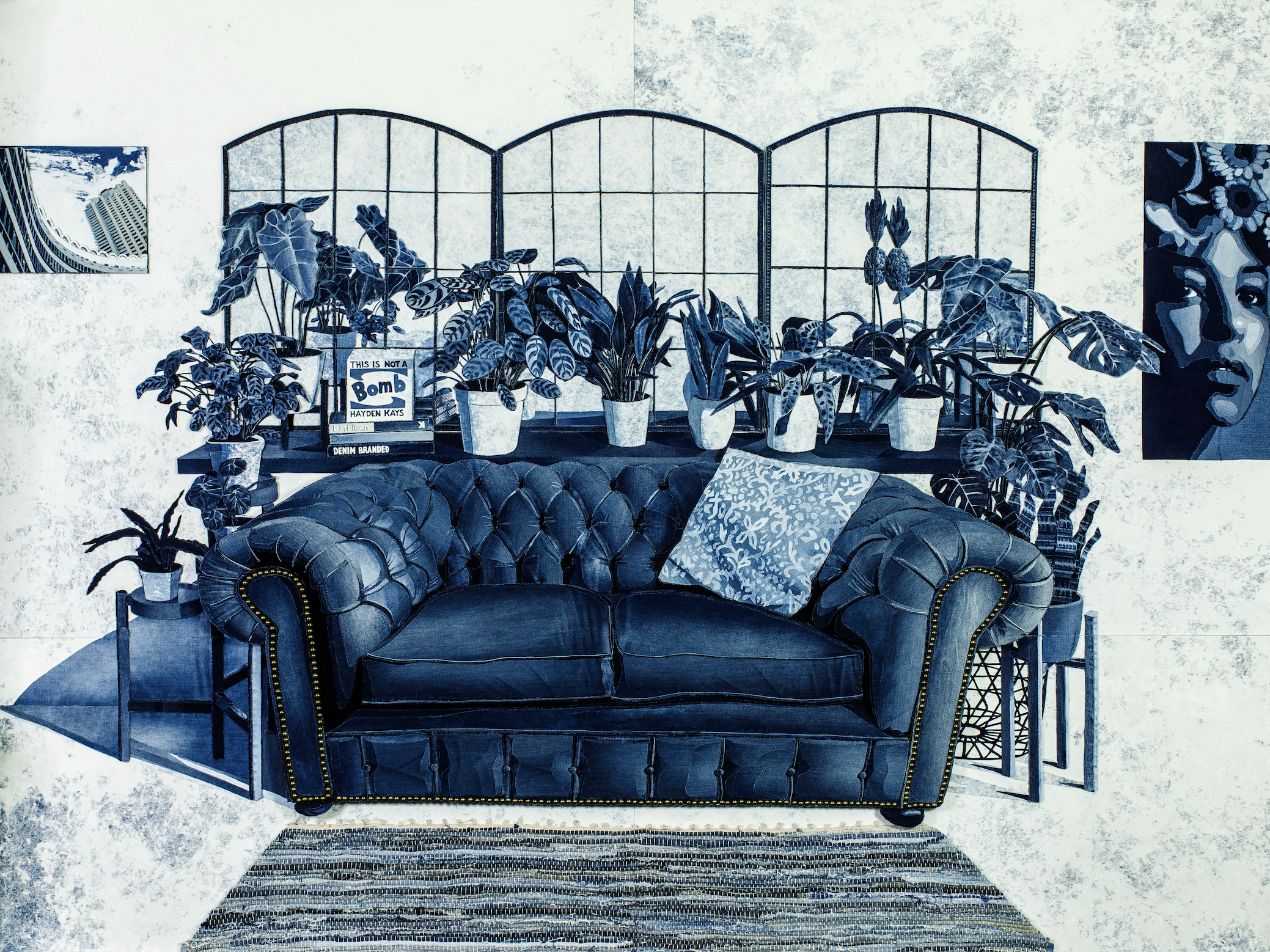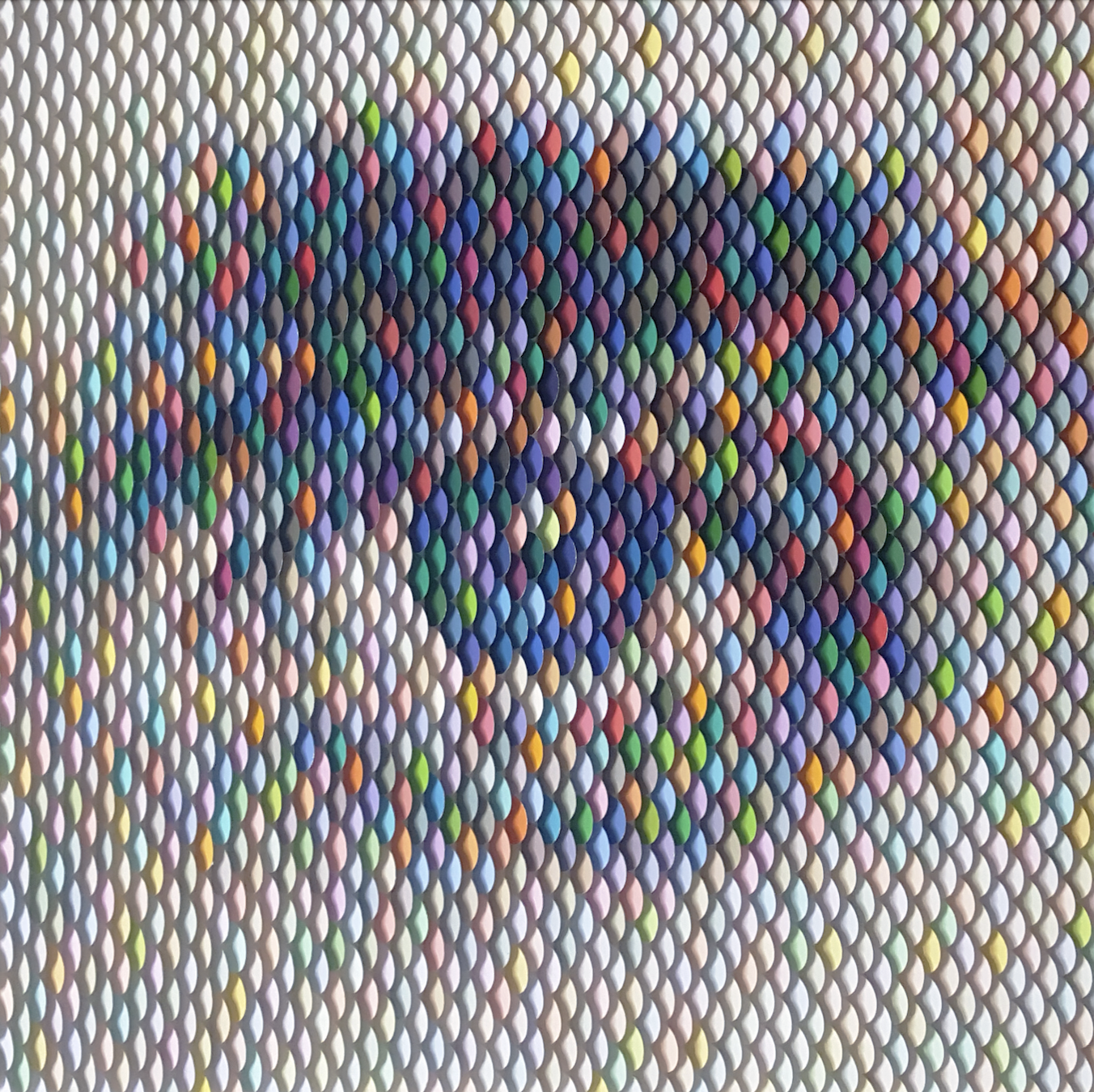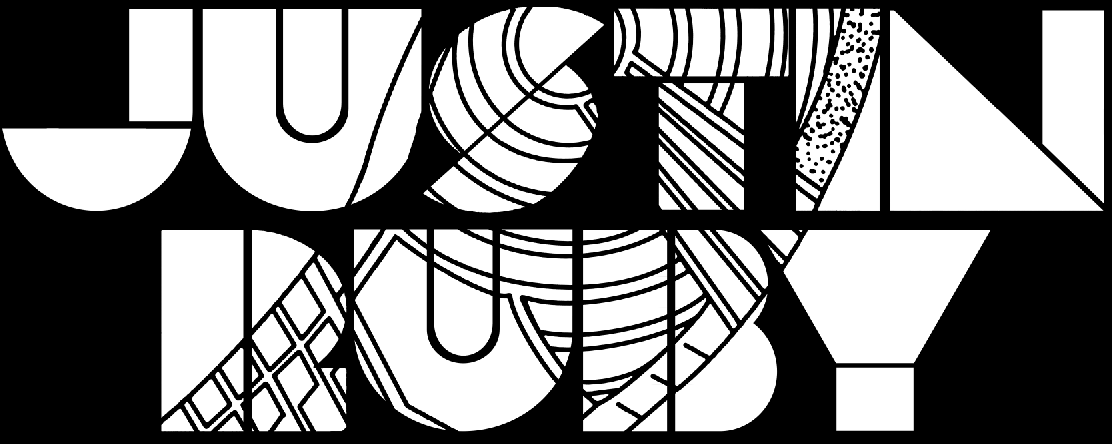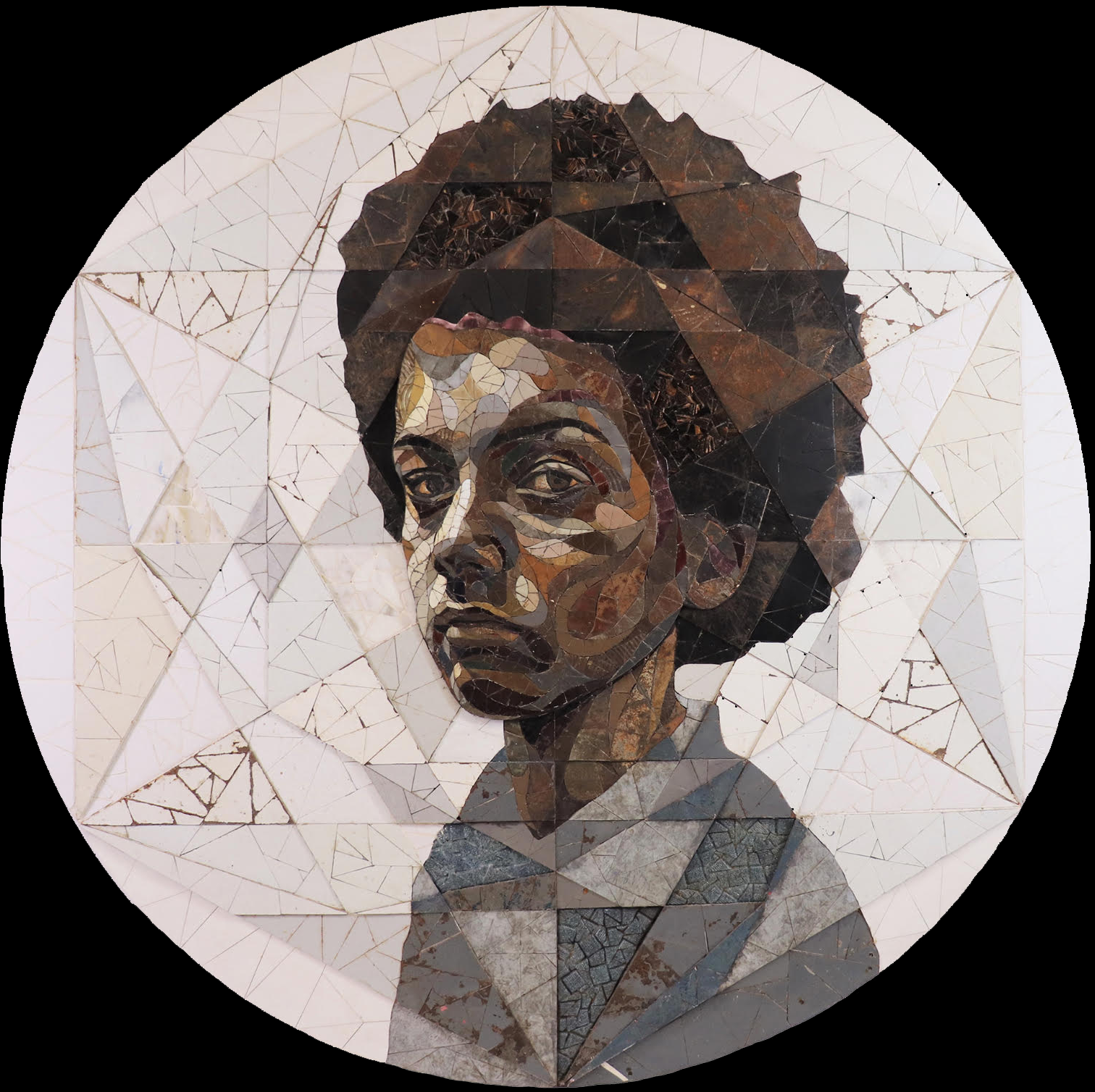The 9 Artists that make up the debut showing of Art Materialism at Catto Gallery, London.
Denim
Huddersfield-born Ian Berry has enjoyed a stratospheric rise since his first Catto Gallery show in 2012. The artist, who fashions unwanted denim into compelling portraits, scenes as well as installations, is now one of the UK's bona fide art world stars. Since his last Catto show in 2019, Hotel California, he was one of the busiest artists in the world during covid, with the Catto supported museum tour around Europe being planned, and all going ahead, with restrictions.
But not content with that he ended up embarking on a charity project for the NHS with his son, Elliott. #iclapfor saw a pair of denim blue hands clapping projected on buildings around the UK and other countries around the world and saw him join the likes of Ringo, Keira Knightly and Joe Lycett with Pin Your Thanks and collaborated with triple Oscar winning costume designer, Jenny Beavan on a special denim jacket that raised thousands for Volunteering Matters.
Covid wasn’t to stop the determined artist, and the Museum Tour took in Basel, Buttenheim in Germany (the home of Levi Strauss), Museum Rijswijk, the Netherlands, Textil Museet – The National Textile Museum in Sweden and MuseumQuartier Osnabruek, Germany and all proved to be a success with record visitor numbers to the venues and glowing reviews. Covid had stopped the artists plans for what to show, and he ended up looking closer to home, new works include pieces based on his living room.
Who else would Levi’s choose to commemorate their 150th anniversary of the 501 jean? Ian exhibited a giant 10x4m fresco shown in iconic locations in Paris, Milan and Madrid. Not content with Europe he completed the portraits of three prominent Chilean musicians that are now displayed in the Santiago Metro.WeAR magazine named him as a top 100 influential person in the Denim Industry earlier this year.
Already with high-profile commissions from the likes Georgio Armani, Ayrton Senna’s family, Debbie Harry, Giselle Bundchen and more this year Berry added set designer to his CV after created one for Ja Rule in New York.
Paint Swatch
Peter Combe has been experimenting with cut and paste collage works since the mid-nineties when he was Artist in Residence at Xerox Canada. Back then he would use the company's colour-copier equipment to assemble his portraits. Today, his favoured medium is the household paint swatch. Peter selects from the full spectrum of 1,100 colours and hand-punches the chosen swatches into small disks. He then fits these disks into bevel-cut grooves on a specially prepared archival material. He describes the effect as akin a to Pissaro-esque pointillist finish.
He says; "There is a magic that occurs, a trick of the eye where colour seems to occupy space – a void – at once ethereal, yet seen from another angle the whole appears as if a ghostly image, veiled in gossamer. It is these characteristics that propel me forward and to continue experimenting with the interplay of colour, light and movement."
Peter was born in Canada but has been based in San Francisco since 2008. His work has been featured in more than 100 shows and art fairs across North America, Europe and the Middle East.
Crayons
During Christmas 2005, Christian Faur’s daughter opened a box of 120 Crayola crayons. Nice gift for a young girl. But the biggest impact was on Christian. The Ohio-based artists had been experimenting with painting using wax, but he didn’t feel the results were satisfactory. Then he saw the crayons. Chistian’s revelation was to use the crayons not as a medium but in the work itself. Soon after, he started assembling thousands of individual crayons to produce single, pixelated artworks.
Then he would pack the finished pieces into wooden frames. Galleries and collectors loved his unique approach. Later, Christian created a ‘crayon alphabet’, assigning a letter to a different colour, which led him to hide messages in his paintings.
He says he is inspired by nature: “There are hidden layers of complexity present in even the simplest objects...in my work, I try to mimic these elegant structures by developing systems with which to express my thoughts and ideas, so that the medium and the message appear as one. I think of them as complex visual “poems,” which can redefine the way we think about the meaning of communication.”
Sneakers/Car upholstery
Art made from training shoes? Really? Yes, really. Although he would call them sneakers. This is the speciality of US artist Justin Ruby and it's taking the world by storm. Pennsylvania-born Justin began his experiments while at school in the early 2000s, turning his pair of Air Jordan 7 French Blues into a self portrait. It was for a college application, but it turned into much more. Justin stuck with the technique, later adding used materials ranging from Louis Vuitton bags to Tootsie Pop Wrappers, to his 'palette', as well as disused car upholstery.
Justin's novel approach won him several college offers, but he decided instead to pass up the opportunity and start his professional career right away. In 2019, he landed his first solo exhibition at the gallery in the G-Shock store in Soho, New York. Eventually he garnered national attention. Among his customers were hip hop culture giants such as Rusell Wilson, Lil Durk, J Prince, and Drake.
This has been especially gratifying for Justin, who grew up much more interested in sport and music than in art. But with his chosen method he successfully blended all of his passions. More recently, Justin completed a three-story mural that was shown at York College of Pennsylvania. He also participated in the boom of NFTs with his sold-out “100 Acre Wood” drop on OpenSea.
Tulle
British born Benjamin Shine is best known for his pioneering work in tulle, the 'floaty' fabric made from nylon, rayon or silk. He developed his unique technique while studying fashion at the Surrey Institute of Art and Design, and later at Central St. Martins. He says he became obsessed with creating clothing from a single length of fabric. But eventually he saw even more potential in using fabric as a medium through which to create ideas away from the body. He settled on tulle when he happened to notice a crumpled ball of it on the studio floor. Benjamin then developed a method of pressing a single length of tulle fabric under glass to create unique and striking portraits.
For the last two decades, Benjamin's work has been exhibited and purchased by private collectors and arts institutions including the Metropolitan Museum of Art, The Museum of Arts and Design New York and The London Design Museum. Clients and collaborators include Beyonce, Givenchy, Maison Margiela, Bergdorf Goodman, Barclays Wealth, British Telecom, Refinery 29, Google, Barnes and Noble and MTV.
He says: "I actually think of myself as a creative explorer and inventor. I’m an ideas person, and while my work often gets classed as art, painting, sculpture or design, it’s all a form of invention and creative thinking. If the end results provoke the reaction “How?” or “Wow!”, then I’m satisfied it has connected and made a positive impact."
Scrap Metal
If we live in a disposable society, then London-based Matt Small makes art from the least valued of all waste materials: old baked bean cans, abandoned car bonnets, discarded street signs. He re-purposes these unloved bits of scrap into something new and magical – striking art work of great skill and immense heart. His subjects are often people Matt describes as "young, dispossessed people, individuals who feel undervalued, who don’t have a voice, who get looked over." And, of course, there's a connection between his raw material and his subjects.
Matt says: “That oven door, that shelving unit – they might be a piece of trash to someone, but I don’t see them like that. I see that they can be something beautiful and worthwhile. That’s how I see our young people too. Let’s look at their potential, at the hope that’s in all of them."
Matt was born in 1975, and graduated from the Royal College of Art in 2000. He has shown at the Saatchi gallery and Black Rat Projects in the UK, but he has also found acclaim internationally. In Oregon, US, he created a mosaic of the athlete Jesse Owens from scrap metal for the 2021 World Athletics Championships. He’s now working on a similar public piece of Jamal Edwards for the entrepreneur’s London neighbourhood of Acton.
Textured Wallpaper
It might be an insult to compare a work of art to wallpaper. But not to David Wightman. His work is literal wallpaper. The Stockport-born artist creates beautiful paintings and prints of fictional landscapes entirely from rolls of the material. David's conversion to the technique came when he was studying at the Royal College of Art in London and found a forgotten roll of wallpaper in a store cupboard. It transported him back to his childhood home, whose walls were all wallpapered. He began experimenting, assembling layers of textured paper and then painting over sections to create imaginary vistas inspired by his beloved walks in the Peak District.
David says: "Wallpaper for me evokes nostalgia and aspiration. So I want to take a material that is not beautiful in itself and see if I can make something beautiful from it.” He obviously succeeded. Over the last 20 years, David has exhibited in a succession of solo exhibitions across the UK and also in Canada, US, Sweden, Singapore and Greece. In 2010, he was awarded the Berwick Gymnasium Arts Fellowship – a six month residency funded by Arts Council England and English Heritage. And in 2013, he was selected by the curator of House Arts Festival, Mariele Neudecker, to make a site-specific painting for a disused pavilion on Brighton’s seafront.
Packing Tape
In this age of online shopping, architects are designing apartment blocks with space for postal deliveries. Yes, parcels are everywhere. And so, inevitably, is packing tape. Maybe Dutch artist Max Zorn anticipated this huge cultural change when he fixed his first translucent tape artwork to a lamp post in Amsterdam in 2011. Max had been developing his audacious method for a while – using nothing but brown packing tape and a scalpel to create vivid urban nightscapes. When he attached his work to streetlamps, the bulbs acted as lightboxes and lit up his images for all to see.
He says: "I was always a big fan of using the city as the backdrop for art. But I felt one aspect was underrepresented: street art that appears at night, when a city changes its face. So, I came up with the idea to use thousands of city lights as an urban gallery. My first artwork was stolen a long time ago, and I’ve forgotten the bruises I got while climbing that lamp post. But it was the first tape, and a lot followed."
What exactly followed was that Max's street art went viral. Soon after, the artist started selling his work. Max recreated scenes from movies and made portraits of icons of popular culture. More recently he expanded his range still further, introducing more colour and taking on large and ambitious crowd scenes. Max's work has been on display constantly since 2011 across hundreds of shows. Recent exhibition venues include the Museum of Urban and Contemporary Art in Munich and the Scope Miami Beach Art Fair during Art Basel Miami Week.
ART MATERIALISM AT
CATTO GALLERY
100 Heath Street, London, NW3 1DP
Monday - Saturday 10 - 5.30pm
Sunday 12 - 5pm
T +44 (0) 20 7435 6660



















